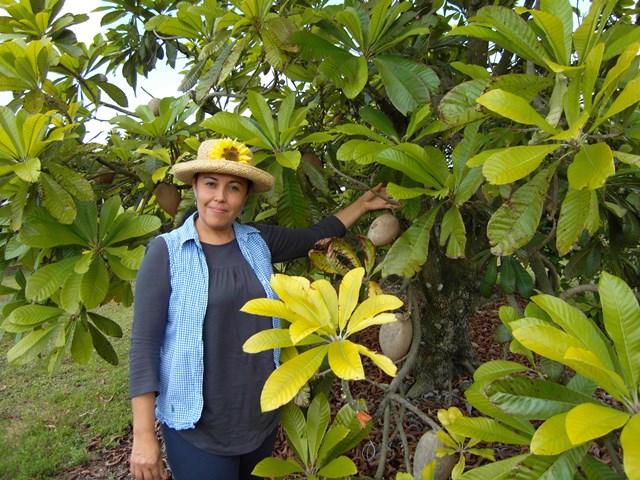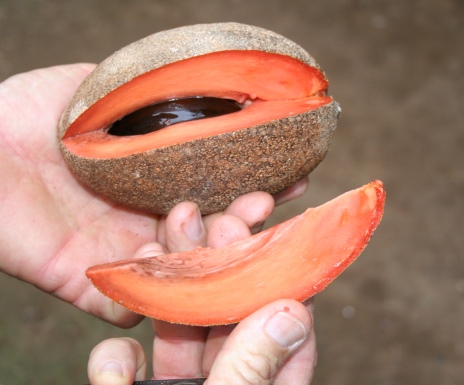From Fairchild
Tropical Botanic Garden
by Noris Ledesma, Curator of Tropical fruit
The Mamey Sapote
in South Florida
As published in the Miami Herald
Under the Florida sun, mamey trees grows in some backyards in South
Florida. From massive branches that shoot straight out to grow
football-shaped fruits with leathery skin the texture and color of
sandpaper.
Mamey sapote (Pouteria
sapota)
is native to the seasonally dry forests of Mexico and Central America.
It was widely distributed in Central America before Columbus and
introduced to the Caribbean, South America, and Asia. Mamey sapote has
been grown in South Florida since the mid-1800 and of all tropical
fruits; mamey is the one that represents the nostalgia for Cubans.
Exiled Cubans longed for a steady supply of mamey and are willing to
buy it at any price.

Those
who know it well believe that there is no better fruit. Its creamy
texture and rich flavor are unmatched. The mamey sapote is a
large-spreading canopy tree. The fruit are form directly on the thick
twigs and branches. Nothing about the stark exterior of the fruit
prepares you for what is revealed when you cut one open; a long and
shiny black seed, reveling the red salmon color of the flesh. The pulp
is aromatic and sweet, soft when ripe, almost fiber free.
The
mamey sapote is usually eaten fresh. When purchasing mamey sapote, make
sure its skin is free of blemishes and that it is firm and mature.
Maturity is best determined by nicking the thick skin with your
fingernail. A mature mamey sapote should have a red or pink flesh
color. If the flesh color is green, the mamey sapote is not mature. To
ripen the fruit at home you will need to leave them at room temperature
until the fruit softens.

Although
mamey sapote fruit can be eaten fresh, popular uses for it include
adding it to fruit salads, desserts, milk shakes and other fruit
drinks. Because of its interesting taste and texture, the mamey sapote
fruit is rapidly gaining in popularity for cooking purposes.
Additionally, mamey sapote is high in vitamins A and C, as well as in
potassium. It is also an excellent source of dietary fiber. The famous
delicious milkshakes from the Caribbean are prepared from mamey sapote.
Growing Mamey
Sapote in South Florida
In
South Florida the greatest part of the fruit crop matures from May
through September, but some mature fruits can be found at any time of
the year. Often flowers, immature fruits, and mature fruits will be
present on a tree at the same time. An individual fruit takes more than
a year to mature on the tree.
They are still some mamey sapote
groves in South Florida, and the majority is the ‘Pantin’
cultivar. Other varieties are Pace, Viejo and the gigantic
“Magaña’. All of these varieties are available in
local nurseries including some of the new Fairchild selections:
‘Lorito’, ‘Cepeda Special”, which were selected
for its productivity and red colored flesh.
Pruning:
Mamey sapote is a vigorous tree. For the gardener with plenty of space,
mamey sapote can make a picturesque specimen for your backyard.
Training the tree is one of the principal requirements to grow it. The
tree usually will develop a desirable shape. Big trees can be in danger
of damage to the tree and its surroundings during windstorms. Each year
after harvest, trees shoud be pruned, removing the upright branches and
keeping the tree 6 to 8 feet tall.
Fertilizing:
Mamey sapote trees grows well in a warm and sunny and preferably
frost-free location. Trees prefer well-drained, sandy soil with regular
applications of water to young trees. Addition of plant mulch to the
soil surface will improve water-holding capacity, nutrient retention
and availability to soil structure. Fertilization is best done with
three applications per year - March, July and September - with an 8-3-9
application or other fruit tree formulation.
Welcome back to the mamey sapote and the Caribbean and the Aztecs roots
even if you have not physically moved. Good growing!
Back to
Mamey
Sapote Page
|
|

